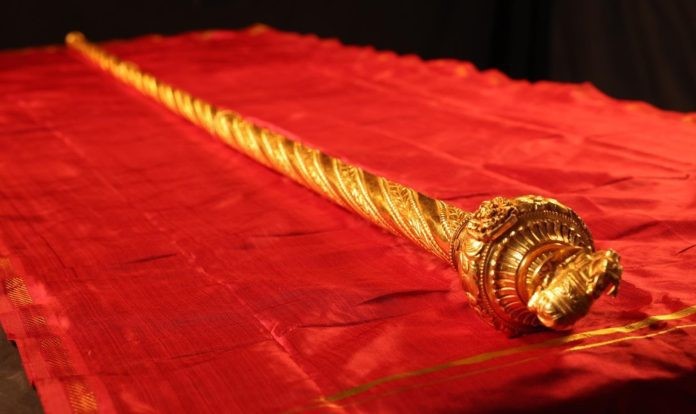Description

Disclaimer: Copyright infringement not intended.
Context
- On 28th May, Prime Minister will receive the sacred symbol of fair and equitable governance, Sengol and install it in the new Parliament House.
Details
- This is the same Sengol that was accepted by the first Prime Minister of India Nehru at his residence on the night of 14th August, in the presence of several leaders.
- On this night Jawaharlal Nehru received the 'Sengol' from the Adheenams (Priests) of the ThiruvaduthuraiAdheenam (Mutt) in Tamil Nadu, who had specially arrived for the occasion.
- The Prime Minister took a decision to adopt the Sengol as a national symbol of the Amrit Kaal.
About Sengol
- The Sengol is profound in meaning, which is derived from the Tamil word “Semmai”, meaning “Righteousness”.
- It is blessed by the high priests of a leading Dharmic Mutt in Tamil Nadu.
- The Nandi, with its unyielding gaze as the beholder of “Nyaya”, is hand-carved at the top.
- Most importantly, the recipient of the Sengol has the “order” (“Aanai” in Tamil) to rule justly and fairly.
Significance
- The establishment of "Sengol", makes the spirit of 15 August 1947 unforgettable.
- It is the symbol of the promise of boundless hope, boundless possibilities and a resolve to build a strong and prosperous nation.
- It will be a symbol of the Amrit Kaal, which will witness the glorious era in which India will be taking its rightful place.
Why was the Sengol given to Nehru?
- According to the official document, just before Independence, Lord Mountbatten, the last Viceroy of India, asked Nehru about “the ceremony that should be followed to symbolise the transfer of power from British to Indian hands”.
- The soon-to-be prime minister went to consult C Rajagopalachari, the last Governor-General of India, who told him about a ceremony performed during the Chola dynasty, in which the transfer of power from one king to the other was sanctified and blessed by high priests.
Traditional Chola practice
- It was a traditional Chola practice for Samayacharyas (spiritual leaders) to lead the coronation of kings and sanctify the transfer of power.
How was the Sengol made?
- Constructed by two men — Vummidi Ethirajulu and Vummidi Sudhakar, the sceptre measures five feet in length and has a ‘Nandi’ bull on top, symbolising justice.
Where is Sengol kept?
- Till date, Sengol was kept in a museum in Allahabad and will now be taken to the new Parliament House.
Sengol's installation ceremony
- The occasion is likely to be steeped in Tamil tradition.
- A group of musicians playing Tamil Nadu's traditional instrument, the Nadaswaram, would lead the procession.
- Additionally, "Adheenams," or priests from Shaivite mutts in Tamil Nadu, will be present in the Lok Sabha's Well. The priests will sanctify the Sengol with holy water after PM greets them at the well.
- The in the background as the Nadaswaram musicians enchant with their soulful music.
- The Sengol will be presented to the prime minister after this revered ceremony and placed in a glass case next to the Speaker's seat in the House.
|
PRACTICE QUESTION
Q) The establishment of Sengol will be a symbol of the Amrit Kaal, which will witness the glorious era in which India will be taking its rightful place. Comment. (150 words)
|

https://pib.gov.in/PressReleasePage.aspx?PRID=1926883















